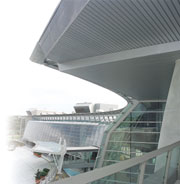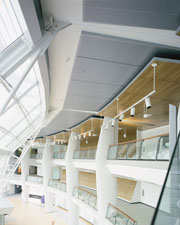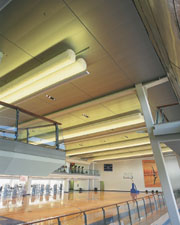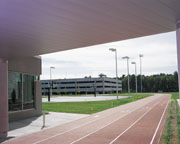

The Chicago Athenaeum awarded the headquarters the “American Architectural Award,” stating that it was one of the 30 most profound architectural designs for 2000. Gravity-defying wall and window curves, tight angles, sleek high-tech interiors combined with an openness, define the new Reebok International Ltd. The 522,000 square-foot headquarters was completed in 2002. Inside, ceilings curve into walls, walls appear to change colors, and an undulating “spine” connects work and recreation spaces.
Included in the striking design are the ceilings, supplied primarily by Hunter Douglas Architectural Products Inc. The ceiling products were chosen to fit in with the sleek, high-tech, yet inviting feel of the building, while offering durability and easy maintenance. The designers used environmentally sensitive products, designed the building to conserve energy and preserved a maximum amount of green space around the complex.
Architects wanted to create a sense of movement, achievement, and cutting-edge creativity to reflect the company’s personality and goals, according to NBBJ spokesperson Bonnie Duncan. Completed in spring 2000, the headquarters house about 1,600 employees, a 30,000-square-foot fitness center, 8,500-square-foot dining area, two parking garages and an exhibit hall.

Time to make the doughnuts
“It’s a beautiful building. In some parts, there is almost a doughnut effect, with the ceiling and walls curving around each other,” says Tom Ayres, vice president of sales and marketing at Hunter Douglas’ headquarters in Norcross, Ga. “Some of the things that we worked on included accommodating the many different planes and curves as they intersected with each other. When dealing with manufactured parts, installation can prove to be a challenge. But it worked!”George Fletcher, independent sales agent with Architectural Design Resources Inc., supplied the various materials needed for the job. Products included Linear Metal, Wide Panel, Plank Ceiling and the standard Open Cell Ceilings.
The Luxalon 300C Wide Panel Ceiling System was used for the outdoor soffits. The panel size meant fewer panels were needed to provide the uninterrupted expanse and a clean visual appearance. Box 4 Linear, used in the outdoor terrace, was installed on a radius. It was chosen because of its flexibility, which allows for different visual effects and it can accommodate radial ceiling lines.
The Box 4 system was also used in the indoor terrace area, where the ceiling curves into the wall.
“The Box 4 system used in the terrace was a fairly standard installation, but was installed on a curve,” says Joe Corkery, project manager with Central Ceilings Inc. “The metal ceiling curved from the floor, up the wall and curves overhead and down into the opposite wall.”
Corkery’s crew spent about six months installing the nearly 100,000 square feet of ceiling material.

Sizes 2 to 10 available
For the ceiling above the spine, Hunter Douglas Luxalon Planks were used, which are designed to cover large spaces with precise flatness. In the fitness center that reaches three stories in height, 2-feet-by-10-feet planks backed with sound absorbing fabric were installed.“Acoustics were a major consideration in the open areas, including the gymnasium because of the size and the uses,” says Corkery.
The benefits of these planks offer high acoustical NRC values. They also allow for easy access to the plenum, and accommodate industry standard light fixtures and air diffusers.
The Open Cell Ceiling System was installed in the bathrooms, Corkery says.
“They (Reebok) were pretty insistent that the bathrooms look just like they did in the old building.”
The resemblance to the old building ended with the bathrooms. Throughout the rest of the complex the sleek, energy-infused look takes over.
“Despite the shape of the building and the multiple curves, very little special manufacturing was needed. We had to carefully fit the materials so that they appeared to be curved when they were not,” says Fletcher. “What made the difference here was the unique way in which the material was used. The ceiling material wrapped down part of the wall, requiring a special finish because they would be more likely to be touched. It’s an example of how materials can be used in different forms.”
While the products used were standard, installing them was a bit of a challenge.
“The outdoor soffits were 40 feet off the ground, the planks above the spine in the lobby area also were 40 feet high, and the gym ceiling is 24 feet high. The metal ceiling span between the steel beams also proved to be tricky,” Corkery says.
The planks used had a length of 10 feet, making them highly suitable for the huge expanse of the ceiling.
“We didn’t mock this up, we did a lot of shop drawings and revisions to the drawings, and so it was all built off the shop drawings,” Fletcher says, regarding how few of the ceilings had to be customized. “There was also good communication with the other trades. For example, a metal ceiling that curved down was made to match the curve of the wall, so we just followed the drawings for that and it worked out well.”
Corkery agreed, saying there wasn’t too much field engineering done during construction, but “looking at the blueprints, you couldn’t tell what everything was going to look like.”
Fletcher provided a great deal of support when there were any questions of how and if something would work, says Corkery. “George was a tremendous help to us.”
“I’m thrilled with the way it worked out. There are a lot of unique features in this building. It’s very sleek and futuristic looking with a lot of tight angles and curves. It’s a high-tech look that’s very popular in Europe,” Corkery says.
NBBJ spokesperson Bonnie Duncan notes: “This world headquarters is a place that integrates people’s lifestyles with the company’s identity, and inspires employees to push themselves with the same energy that is embodied in the architecture.” W&C

Report Abusive Comment